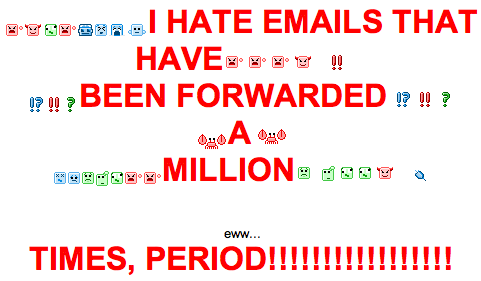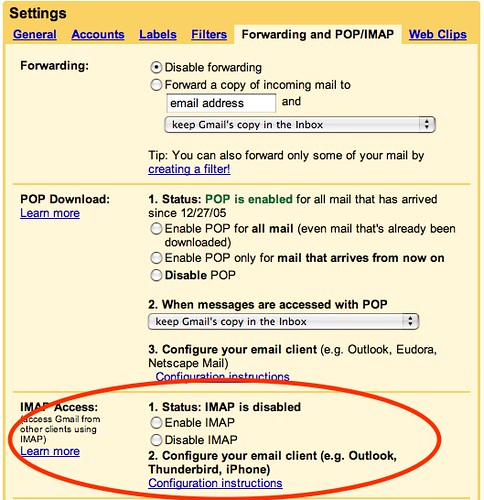Penmachine
08 January 2009
The wisdom of the kid
My daughter is 10, but she has already learned something about email that I didn't get until I was in my 20s. A screenshot of the message she sent me earlier:
Well said. We'll work on that layout and typography as she gets older.
P.S. Here's what her younger sister, age 8, just said to me now in tones usually reserved for chocolate vs. regular milk: "Dad, instead of Safari can I have Firefox?"
Labels: controversy, email, family, geekery, spam
15 September 2008
Super-awesome new Gmail feature
If you use Google's Gmail, check out the experimental Google Labs settings. There are several cool options, but I turned on the newest one right away: the Forgotten Attachment Detector.
"Many of us have experienced the embarrassment of having sent a message without attaching the file we said we were going to attach," writes author John Kotker. "Turn on the Forgotten Attachment Detector in Labs, and you'll get an alert if you mention attaching a file but forget to do so."
That's a small little bit of awesomeness added to my day. (Via Steve Rubel.)
Labels: email, gmail, google, web
30 August 2008
Public service announcement: learn your own email address
None of the people I'm referring to will ever read this message, but I have to get it off my chest:
Please learn your own damn email address!
Over the past year, I've received numerous email messages from airlines, mailing lists, and even MySpace, sent to my Gmail address (I'm dkmiller over there, as I am here). While I've used Gmail as my main email interface since the beginning of 2006, that's not the address I give out to people—I either use my address here at penmachine.com or the forwarding address I've had at pobox.com since 1996.
However, there are a few people out there—a guy named Darren Miller, a gal named Debra Miller, and others (all in the U.S. so far), who seem to think their email addresses at Gmail are the same as mine. Thinking it's their own, they have entered my address into airline reservation systems, MySpace profiles, Volkswagen buyer registration websites, and various subscription forms. Which means I get emails intended for them.
If I were a bad person, I could do all sorts of nasty things to them because of their mistake—quite often I get a copy of their password in the first message, and if they're like many people, that password probably works at a whole bunch of different places. But instead I try to contact them (if I can get the info), or tell the places they registered about the problem, or (worst case, as at MySpace) simply cancel the registration so I stop getting the messages.
So, to everyone who does actually read my site here, when you're putting your email address into a website form, please make sure it's the correct email address. If you don't get a confirmation message from the site, be suspicious. If your private information is being sent to an incorrect email address, all sorts of things could happen. Thanks.
27 October 2007
Geekiness and nerdery
 Wired reports that Mark Crispin, the guy who invented the IMAP email protocol more than 20 years ago, is unhappy with Gmail's new implementation of his creation. "The consequences of the current [Gmail IMAP] server being presented as a completed product," he says, "would be far worse than their not doing IMAP at all."
Wired reports that Mark Crispin, the guy who invented the IMAP email protocol more than 20 years ago, is unhappy with Gmail's new implementation of his creation. "The consequences of the current [Gmail IMAP] server being presented as a completed product," he says, "would be far worse than their not doing IMAP at all."
Similarly, Nancy McGough, who maintains a remarkably obtuse page about IMAP that includes a strangely-sorted list of IMAP email providers, is now optimistic about IMAP, but still laments that, "We need e-mail messages to be linkable, annotatable, and access-controlled. Basically we need all our e-mail in a wiki with multiple levels of access control..."
Whoa. Okay, okay. Let's calm down a little. I can't imagine my in-laws managing their email as a wiki with multiple levels of access control, you know. As someone who has been a little obsessive about validated HTML, I can understand the geeky impulse for wanting standards (especially ones you've invented, or spend a lot of time on) being fully supported. But if you check right now, this web page doesn't quite validate—mostly because I occasionally embed YouTube videos (also owned by Google) on my site, and their default code is broken.
You know what? That's okay. The Internet is a success because of Postel's Law ("be conservative in what you do, be liberal in what you accept from others"), and while Google isn't following it—they're being a bit sloppy in what they do with IMAP, as with many other things—the rest of us can follow our part. I can accept Google's sloppiness, at least temporarily.
Just to note, Gmail is still labeled a "beta" product (almost four years of that so far!), so Google has a theoretical excuse here. Yes, IMAP's benefits were obvious even a decade ago, and many services like Apple's (for-pay) .Mac have offered it for a long time. In fact, I was using IMAP without knowing it when I used to check my university email with pine through a 2400-bps dialup modem back in 1992.
Douglas Adams had a wonderful definition of a nerd: someone who uses a telephone to talk to other people about telephones. One of the problems with many open-source and other geek-driven IT initiatives (like IMAP) is that they're often wrapped up in nested vortices of nerdery that demand note-for-note perfection in implementation—perfect for emailing other nerds about email. Google's approach, while imperfect, is also pragmatic: get it out there and fix it over time.
Obviously Crispin and McGough see that too. To them it appears to be a nasty set of flaws; I think it's just real humans trying to make something work. My website here—a much smaller example—started out technically problematic, and has generally gotten better over the past seven years. It's good that the alpha geeks behind IMAP are pushing Google to implement it properly. I don't think it's terrible that it didn't start out that way, however.
And speaking of nerdery, check out these awesome jack-o-lanterns. The Death Star one is my favourite.
Labels: email, geekery, gmail, google, holiday
24 October 2007
Getting Gmail's IMAP support to work
I didn't have much trouble getting Gmail's new support for the IMAP email standard to work.
UPDATE: Here are some more very useful tips for IMAP with Apple Mail (and the iPhone). I'll be using them.
Why is IMAP useful?
IMAP is cool because, unlike the more common POP standard, it always keeps your mail on a remote server, and your local email client software synchronizes with that.
The upshot is that, no matter what computer (or other device) you use to read and write email, stuff like latest messages, read and unread mail, deletions, spam filtering, and sent messages are always in the same state. In other words, you get the always-up-to-date benefits of an online webmail system (like Gmail, Hotmail, Yahoo! Mail, and so on), plus the ability to work in a dedicated email application instead of a web browser—and process your email offline, such as on a plane or somewhere else without perpetual Internet access.
So how do I do it?
I've had a few people ask me how to get IMAP working since Google announced the support yesterday. It seems to be a staged rollout, so if you are a Gmail user, you might not see IMAP yet. But if you have it, go to Gmail on the Web and choose Settings > Forwarding and Pop/IMAP:
If you don't have it, the IMAP setting won't be there. If it is, turn it on and save your settings. Then follow the link instructions to set up Apple Mail, Outlook, your handheld device, or whatever you're going to use. (Make sure your email software supports IMAP.) Google's instructions are quite clear.
Once you have your program set up, choose Get Mail or Sync or whatever the command is (see my tip below). Or, if you don't have IMAP in Gmail yet, you'll have to wait a bit until it becomes available to you.
Other tips
I also disabled POP—it was a pain and I rarely used it anyway—just to avoid confusion.
Be prepared for your first sync to take a long time (hours) if you have a lot of Gmail. My 1.6 GB of mail took several hours, so I let it work after I went to sleep. Of course, it also sucked up 1.6 GB on my hard disk in the process.
Labels: email, geekery, gmail, google, web
12 August 2007
Buy more Gmail storage
Via Tod, I find out that you can now pay a yearly fee to buy more online storage for your Gmail account (and other Google services)—up to 250 GB. My free storage is currently at 2.8 GB, and is only about half full, so I'm fine, but it's good to have the option.
Labels: email, geekery, gmail, google, todmaffin

